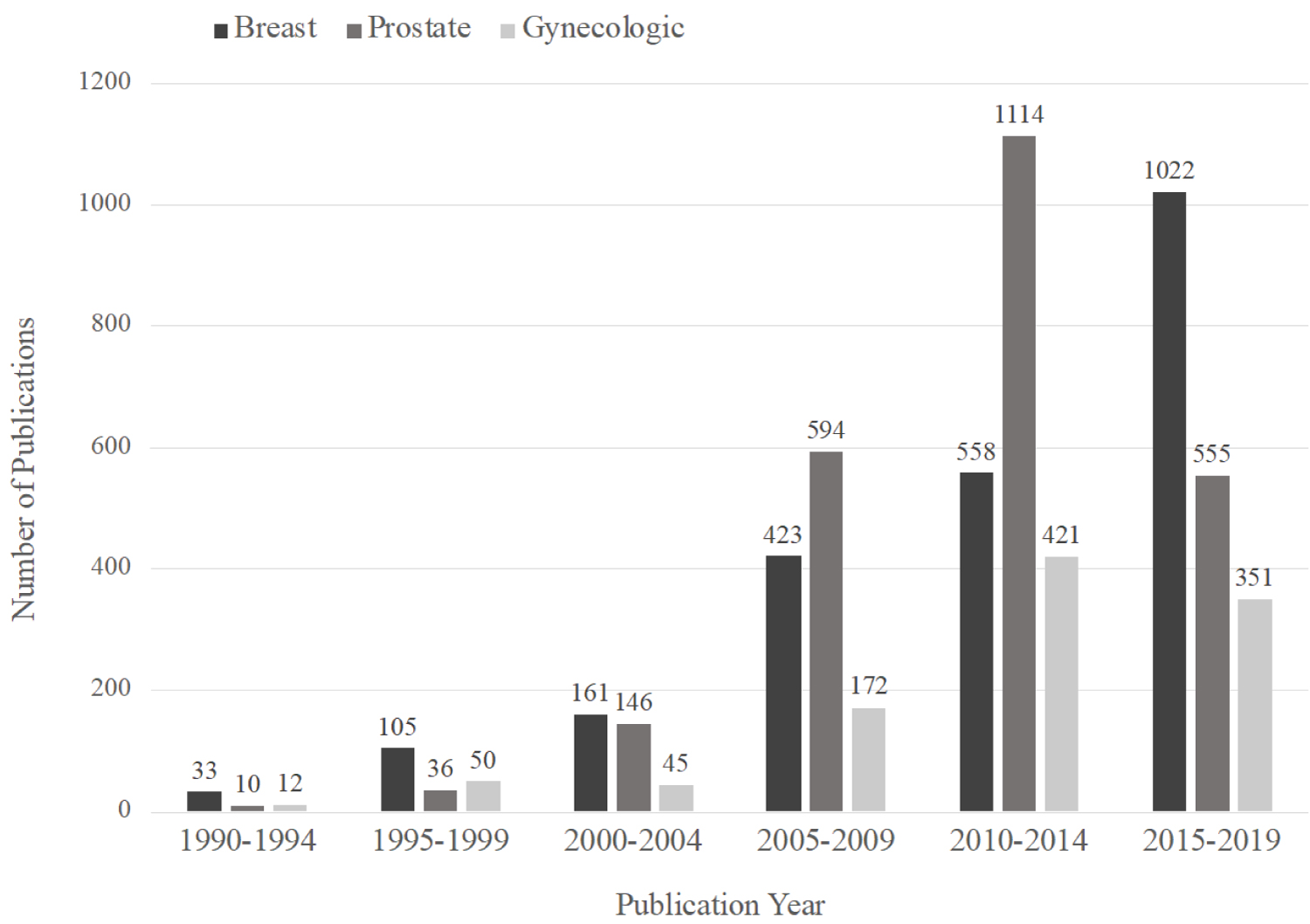Artificial Intelligence Publication Trends in Reproductive Cancers - Who is being Left Behind?
Keywords
Reproductive cancers, Artificial intelligence, PubMed, Publication trends, Health care disparities
Objective
Artificial intelligence (AI) algorithms have been developed to make real-time analyses and decisions that simulate human thinking, with tremendous applications in healthcare. By uniting patient data and medical knowledge, AI can predict for and identify malignancies more accurately and efficiently than a human can [1]. Given the increasing utility of artificial intelligence (AI) in health care, we proposed to study AI research publications in gynecologic oncology. Trends and disparities in AI research were examined in gynecologic compared to other reproductive cancers, including breast and prostate cancer. Furthermore, we evaluated AI research in screening, diagnosis, surgery, and treatment.
Study Design
Searching the PubMed database, we used keywords and MeSH terms to index articles. The National Cancer Institute's Joinpoint Regression Program was employed for statistical analysis [2]. The study used de-identified data; consequently, it was exempt from IRB approval.
Results
A total of 14,721 publications related to AI and oncology were identified from 1990-2019. There was an increase in AI research from 19 to 1,829 research articles annually. Of the total publications, 41% were associated with diagnosis, 30% treatment, 24% surgery, and 5% screening. Although the number of screening publications was lowest, research on screening had the highest increase at 23.6% per year (p < 0.001).
Of 5,808 publications on reproductive cancers, gynecologic cancer articles comprised 18% of publications compared to breast (42%) and prostate (40%) cancers (Figure 1). However, these three reproductive cancers had a similar publication rate over time; breast, prostate, and gynecologic cancer publications had average annual increases of 16.5%, 17.6%, and 16.6%, respectively (p < 0.05).
Within gynecologic oncology, diagnosis, treatment, surgery, and screening constituted 33%, 26%, 25%, and 16% of publications, respectively. In this specialty, cervical, ovarian, and uterine cancers constituted 42%, 33%, and 25% of publications. Ovarian cancer publications had the highest annual increase at 16.1% compared to 14.5% in uterine and 10.7% in cervical cancer publications (p < 0.001).
Conclusion
Among cancer research topics, AI in diagnosis was most extensively published. Furthermore, a disproportionately lower number of AI publications were related to gynecologic cancers compared to breast and prostate cancers from 1990-2019. Ovarian cancer publications increased the highest compared to other gynecologic cancers.
Our results may not be comprehensive as we did not account for publications beyond PubMed, including unpublished data or abstracts. Furthermore, publications may have been repeatedly indexed if they pertained to multiple MeSH terms. To our knowledge, however, this is one of few studies that addresses the trends and disparities of AI research among reproductive cancers.
It is understandable that there are fewer AI publications pertaining to gynecologic cancers due to its lower incidence compared to other reproductive cancers [3]. However, if one accounts for the mortality associated with these cancers, the proportion of gynecologic cancer deaths relative to new cases is 31% as opposed to 16% and 18% in breast and prostate cancer, suggesting that more AI research should be allocated toward female pelvic cancers. With the potential of AI to improve cancer diagnostics and treatments, scientists and clinicians must ensure that AI research is distributed equitably in oncology [4,5].
Acknowledgements
Denise Cobb Hale and The Fisher Family Fund for administrative support.
Conflicts of Interest
The authors report no conflicts of interest.
References
- West DM, Allen JR (2018) How artificial intelligence is transforming the world. Brookings.
- Annual Percent Change (APC) and Confidence Interval.
- Cancer Facts & Figures 2019.
- Emin EI, Emin E, Papalois A, et al. (2019) Artificial intelligence in obstetrics and gynaecology: Is this the way forward? In Vivo 33: 1547-1551.
- Chen IY, Joshi S, Ghassemi M (2020) Treating health disparities with artificial intelligence. Nat Med 26: 16-17.
Corresponding Author
David Pierce Mysona, MD, Department of Obstetrics and Gynecology, Women's Hospital, University of North Carolina, 101 Manning Drive, Chapel Hill, NC 27514, USA, Tel: (706)-664-8452
Copyright
© 2021 Chan JE, et al. This is an open-access article distributed under the terms of the Creative Commons Attribution License, which permits unrestricted use, distribution, and reproduction in any medium, provided the original author and source are credited.





